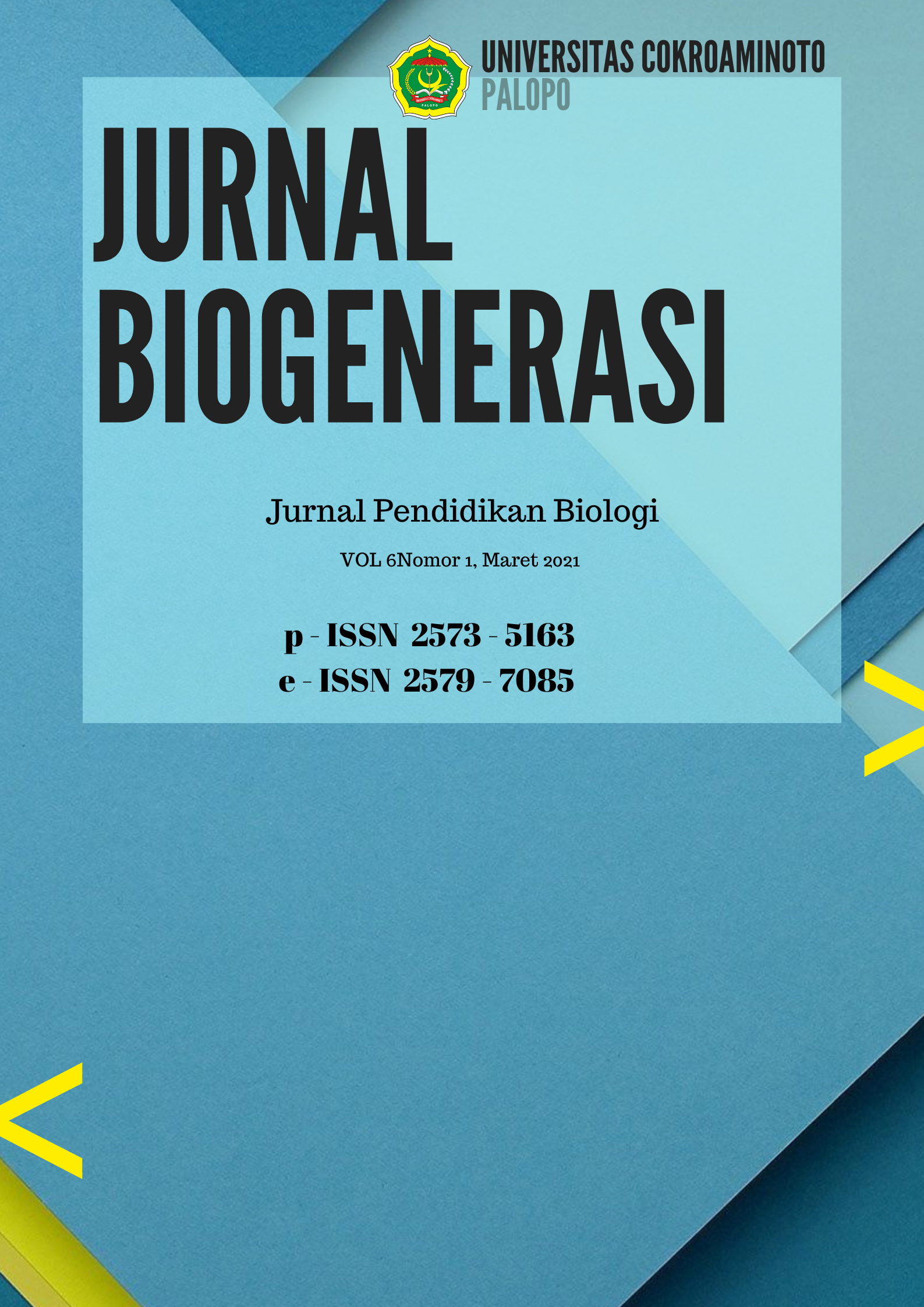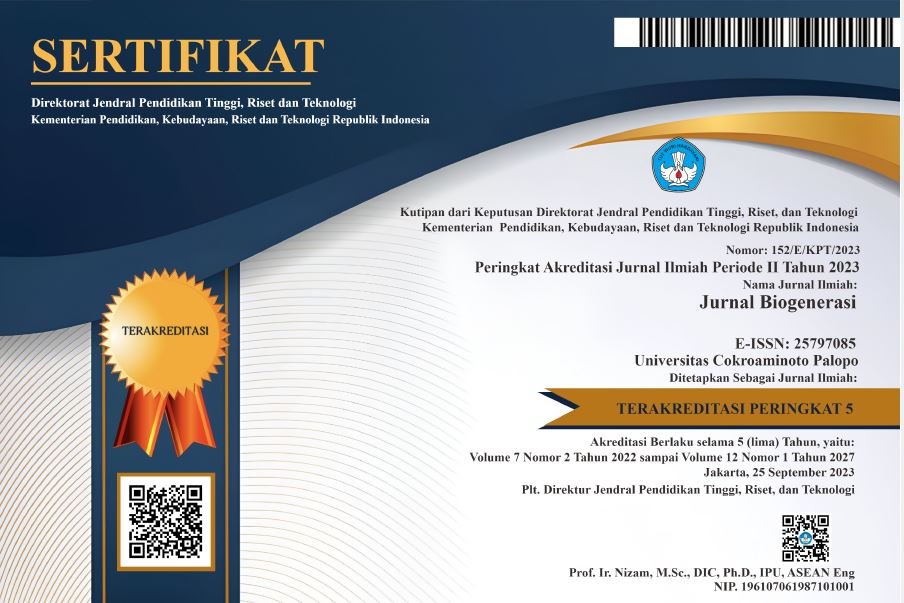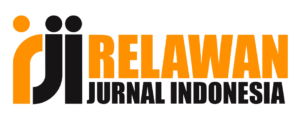ANALISIS KEPRAKTISAN INSTRUMEN PENILAIAN AUTENTIK MATERI EKOSISTEM DI SMA DITINJAU DARI ASPEK PENGGUNA
DOI:
https://doi.org/10.30605/biogenerasi.v6i1.1220Abstract
This study aims to analyze the practicality of an authentic assessment instrument for ecosystem materials in high school which has been developed using the 4D development model (Define, Design, Development, Disseminate) by Thiagarajan. The practicality of the instrument in terms of the user aspect is measured using a teacher response questionnaire filled out by the teacher and also students who are given an assessment instrument to use. Aspects assessed in the instrument are related to aspects of clarity and aspects of understanding/acceptance. Practically, teachers find it easy to use it in assessing student learning outcomes and students who feel enthusiastic about learning that apply authentic assessment instruments. From the results of data analysis carried out, the teacher gave a very positive response to both aspects which were assessed with a student response value of 92.5% greater than 85%. Meanwhile, the student response showed that the students gave a positive response to the implementation of authentic assessment of ecosystem materials with a response value of 84.11%. Thus, it can be concluded that the authentic assessment instrument for ecosystem material that has been developed can practically be used properly and gives a positive response from both teachers and students.
Downloads
References
Nuansa Bayu Segara. 2014. Penggunaan rubrik sebagai alternative assessment pada mata kuliah seminar studi sosial. Edunomic | Volume 2 No. 2 Tahun 2014 Hal. 63 – 69.
Suwarno. 2016. Pentingnya Rubrik Penilaian Dalam Penilaian Keterampilan Vocational Siswa. Prosiding Seminar Nasional UNS Vocational Day. DOI: https://doi.org/10.20961/uvd.v1i0.7208
Neneng Kusmijati. 2014. Penerapan Penilaian Autentik Sebagai Upaya Memotivasi Belajar Peserta Didik. Prosiding Seminar Nasional Hasil - Hasil Penelitian dan Pengabdian LPPM UMP 2014 ISBN 978-602-14930-3-8. Purwokerto, 20 Desember2014 Hal. 55- 62.
Fauziyyah, Ghaida Nurul (2018) Pengaruh penilaian autentik dalam kurikulum 2013 terhadap motivasi belajar siswa pada mata pelajaran PAI. Diploma thesis, UIN Sunan Gunung Djati Bandung. http://digilib.uinsgd.ac.id/16842/
Yamasari, Y. 2010, 4 Agustus. Pengembangan Media Pembelajaran Matematika Berbasis ICT yang Berkualitas. Seminar Nasional Pascasarjana X–ITS. ISBN No. 979-545-0270-1. Surabaya
Badan Pengembangan Sumber Daya Manusia Pendidikan dan Kebudayaan dan Penjamin Mutu Pendidikan. 2013. Konsep Penilaian Autentik Pada Proses dan Hasil Belajar. Jakarta: Badan Pengembangan Sumber Daya Manusia Pendidikan dan Kebudayaan dan Penjamin Mutu Pendidikan. Kemendikbud
Direktorat Pembinaan SMA, Ditjen Pendidikan Menengah. 2013. Model Penilaian Hasil BelajarSMA Kurikulum 2013. Kemendikbud
Mardapi, Djemari. 2012. Pengukuran, penilaian, dan evaluasi pendidikan. Yogyakarta: Medica Publishing.
Wildan. 2017. Pelaksanaan Penilaian Autentik Aspek Pengetahuan, Sikap dan Keterampilam di Sekolah atau Madrasah. Jurnal Tatsqif. Jurnal Pemikiran dan Penelitian Pendidikan, Volume 15 No. 2. Desember 2017.
Ari Astriyandi dkk. 2016. Kemampuan guru menerapkan penilaian autentik dalam pembelajaran PPKN (studi kasus di SMA Negeri 1 indralaya). JURNAL BHINNEKA TUNGGAL IKA, VOLUME 3, NOMOR 2, NOVEMBER 2016
Downloads
Published
How to Cite
Issue
Section
License
In submitting the manuscript to the journal, the authors certify that:
- They are authorized by their co-authors to enter into these arrangements.
- The work described has not been formally published before, except in the form of an abstract or as part of a published lecture, review, thesis, or overlay journal.
- That it is not under consideration for publication elsewhere,
- That its publication has been approved by all the author(s) and by the responsible authorities – tacitly or explicitly – of the institutes where the work has been carried out.
- They secure the right to reproduce any material that has already been published or copyrighted elsewhere.
- They agree to the following license and copyright agreement.
License and Copyright Agreement
Authors who publish with this journal agree to the following terms:
- Authors retain copyright and grant the journal right of first publication with the work simultaneously licensed under Creative Commons Attribution License (CC BY 4.0) that allows others to share the work with an acknowledgment of the work's authorship and initial publication in this journal.
- Authors are able to enter into separate, additional contractual arrangements for the non-exclusive distribution of the journal's published version of the work (e.g., post it to an institutional repository or publish it in a book), with an acknowledgment of its initial publication in this journal.
- Authors are permitted and encouraged to post their work online (e.g., in institutional repositories or on their website) prior to and during the submission process, as it can lead to productive exchanges, as well as earlier and greater citation of published work.



.png)

